The coronavirus pandemic is plunging the global economy into depression, but the full extent of the damage is inevitably still unknown. Most European countries remain in varying states of lockdown, attempting to buy time while they rapidly reconfigure their healthcare systems to tackle Covid-19. But as very early signs emerge that the disease may be peaking in Europe, thoughts are already turning towards what happens next.
There are any number of forecasts of how bad the economic hit will be. The IMF and the UK’s Office for Budget Responsibility produced updated macroeconomic modelling this week pointing to significant falls in GDP in 2020 and beyond. While everyone can agree that we are living through a large economic shock, opinions differ about how long it will last, how it will affect various groups and sectors, and what the world will look like once we reach the other side. How can these views best be interpreted?
We can start by noting that even in benign economic times, there is always a range of views. This in itself is neither unusual nor problematic. What is different here is the level of uncertainty attached to all the forecasts.
At a high level, the future path of the economy will be affected by:
- the spread of COVID-19 to this point as well as the effectiveness of government control measures (including lockdown) and how they have impacted economic activity;
- the trajectory of the virus and what it means for health outcomes, infection rates and the timing of the peak and ebb of the epidemic – plus the associated political and medical objectives, e.g. herd immunity, timetable for vaccine development and distribution;
- the type, nature and effectiveness of government policy responses, including lockdown exit plans; and
- how quickly different sectors ‘reset’, e.g. how will consumer behaviour shift in response to the experience of living and perhaps working at home for extended periods. (Note that Chinese retail sales fell 16% in March compared with a year earlier, even though most stores and restaurants had reopened.)
There is a high degree of uncertainty on all these points. No one can be sure how many people in total have already been infected by the coronavirus and how many have died, let alone how much harm to the economy has been done. It is generally agreed that lockdowns and control measures have significantly reduced output, as would be expected, and that government programmes to support jobs and incomes will cause public sector debt to surge. Some sectors (e.g. travel) have fared worse than others (e.g. food retail), while the blow to household incomes depends on employment status, sector and gender as well as the availability of government aid.
The longer-term economic impact of COVID-19 is unknowable at this point. The OBR’s illustrative assumption is that activity will be badly affected for three months and will then return to normal over the subsequent three months, leaving no lasting economic damage. But the watchdog cautioned that it cannot predict how long the lockdown will last. The IMF offers three scenarios, each involving increasing degrees of economic pain – for instance if lockdowns are extended or repeated. As well as the economic consequences, each path of action has important ethical and political implications. Ultimately, policymakers will need to form a view.
It is not easy to see how these uncertainties can be resolved in the short term. A fundamental rule of modelling is that a model is only as good as the information that goes into it. This applies equally to epidemiology models looking at the impact of a disease on health and to macroeconomic models used to understand its economic impact. In this case, we are still in the relatively early stages of the pandemic. Testing levels mean it is still highly uncertain in most countries how far the virus has spread – the factor which will determine infection rates as restrictions start to be lifted. The experience of countries where the disease first took hold, particularly China, will be informative. But, without specific country data, it is also unclear how that experience can be applied elsewhere.
This pervasive uncertainty means decisions must be made based on variables with wide confidence intervals, as the outputs of available health and economic models illustrate. This is not a criticism of either the quality of the models or of those running them: it simply reflects the limited amount of reliable input data and the reality of our uncertain times. As a result, it is not possible to make a credible forecast of how the world will look over the next six, 12 or 24 months. Still, it would be a mistake for policymakers to adopt a laissez-faire approach. The same goes for business.
A sensible exercise now is to define a set of ‘what-if’ scenarios to draw out implications for planning or to identify avenues for further analysis and customer research. This can help businesses understand how to prepare for continued uncertainty and make strategic choices about where to lead/follow. It can also ensure companies are ready once the crisis starts to abate. The scenarios should address three broad issues:
- the duration of lockdown/social distancing measures;
- the severity and shape of the economic downturn; and
- the extent to which changes to demand and supply in response to COVID-19 persist, revert to pre-crisis patterns or mutate again.
Such exercises can be designed to encompass a range of views and run on data already available to the business.
To summarise, our advice for all decision-makers would be as follows:
- Treat all predictions with healthy scepticism. Don’t feel pressured to offer certainty or be pushed into a single or central view. No one knows how this crisis will play out.
- Update your models and thinking regularly to incorporate new data – particularly your own data.
- Don’t get caught by the sunk cost fallacy. You should expect to change your mind as your information set changes. This is a sign of confidence, not weakness.
- Make sure you understand the impact of different versions of the future on your business and what steps can mitigate the expected impact. And make sure you are ready to implement these measures. The time for planning is now.





